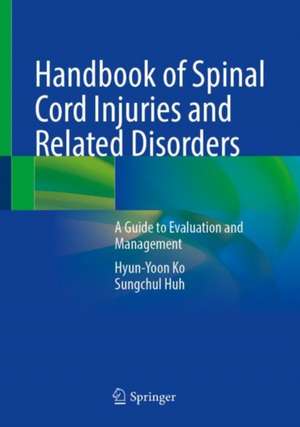Handbook of Spinal Cord Injuries and Related Disorders: A Guide to Evaluation and Management
Autor Hyun-Yoon Ko, Sungchul Huhen Limba Engleză Hardback – 23 oct 2021
Preț: 1455.20 lei
Preț vechi: 1531.78 lei
-5% Nou
Puncte Express: 2183
Preț estimativ în valută:
278.49€ • 287.69$ • 231.77£
278.49€ • 287.69$ • 231.77£
Carte tipărită la comandă
Livrare economică 21-27 martie
Preluare comenzi: 021 569.72.76
Specificații
ISBN-13: 9789811636783
ISBN-10: 9811636788
Pagini: 554
Ilustrații: XXII, 554 p. 108 illus., 67 illus. in color.
Dimensiuni: 178 x 254 mm
Greutate: 1.36 kg
Ediția:1st ed. 2021
Editura: Springer Nature Singapore
Colecția Springer
Locul publicării:Singapore, Singapore
ISBN-10: 9811636788
Pagini: 554
Ilustrații: XXII, 554 p. 108 illus., 67 illus. in color.
Dimensiuni: 178 x 254 mm
Greutate: 1.36 kg
Ediția:1st ed. 2021
Editura: Springer Nature Singapore
Colecția Springer
Locul publicării:Singapore, Singapore
Cuprins
1 Clinical and Functional Anatomy of the Spinal Cord.- 2 Extremity kinematics and muscles for functional training of tetraplegics and paraplegics.- 3 Physical and neurological differentiation of spinal cord lesions.- 4 Laboratory tests commonly encountered in care of spinal cord injuries.- 5 Pharmacotherapy in spinal cord injuries.- 6 Imaging assessment of spinal cord injuries.- 7 Functional assessment and expected functional outcomes following spinal cord injuries.- 8 Standard neurological classification of spinal cord injuries.- 9 Spinal shock: definition and clinical implications.- 10 Acute phase management of traumatic spinal cord injuries.- 11 Clinical syndromes of incomplete spinal cord lesions.- 12 Posttraumatic syringomyelia and Chiari malformations.- 13 Cauda equina and conus medullaris lesions.- 14 Nontraumatic spinal cord lesions/diseases.- 15 Autonomic nervous system in spinal cord injuries.- 16 Cardiovascular dysfunction in spinal cord injuries.- 17 Orthostatic hypotension and associated supine hypertension.- 18 Autonomic dysreflexia.- 19 Venous thromboembolism in spinal cord injuries.- 20 Respiratory dysfunction.- 21 Electrolyte disorder.- 22 Metabolic disorders.- 23 Voiding dysfunction and genitourinary complications.- 24 Bowel dysfunction and gastrointestinal complications.- 25 Sexuality changes.- 26 Spasticity.- 27 Pressure Injuries.- 28 Heterotopic ossification.- 29 Pain types and taxonomies.- 30 Thermoregulatory impairment.
Notă biografică
Hyun-Yoon Ko, M.D., Ph.D
Department of Rehabilitation Medicine, Rehabilitation Hospital
Pusan National University Yangsan Hospital, Pusan National University College of MedicineYangsan, Korea (Republic of)
Sungchul Huh, M.D.,
Department of Rehabilitation Medicine, Rehabilitation Hospital
Pusan National University Yangsan Hospital,
Yangsan, Korea (Republic of)
Textul de pe ultima copertă
This easy-to-use handbook is designed to assist in the evaluation and management of spinal cord injuries and the diverse related disorders and conditions. Spinal cord injuries can cause abnormalities in all body systems due to dysfunction of the somatic motor and sensory systems and damage to the autonomic nerve system. The latter gives rise to respiratory and cardiac problems, temperature regulation disorders, endocrine system disorders, and many associated metabolic disorders. Other potential consequences of spinal cord injuries include pressure injuries and various disabilities and obstacles, ranging from physical limitations to social embarrassment. This handbook offers extensive guidance on medical management in different scenarios from the acute phase to long-term care, with a particular focus on information of importance for the solution of clinical problems commonly encountered in daily practice. It will be ideal for practitioners in rehabilitation medicine, neurosurgery, orthopedics, neurology, and other relevant specialties that deal with patients with spinal cord injuries.
Caracteristici
Provides clear guidance on assessment and management of spinal cord injuries and the related disorders and conditions Designed for everyday use in clinical practice Of value for practitioners in a range of specialties
